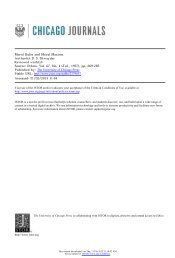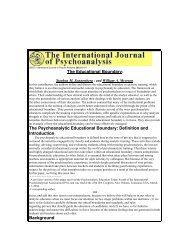A Companion to Linear B - The University of Texas at Austin
A Companion to Linear B - The University of Texas at Austin
A Companion to Linear B - The University of Texas at Austin
You also want an ePaper? Increase the reach of your titles
YUMPU automatically turns print PDFs into web optimized ePapers that Google loves.
§12.1.2.3 SCRIBES, SCRIBAL HANDS AND PALAEOGRAPHY 79<br />
For example, Hand 1, the master scribe <strong>at</strong> the site, 89 is almost obsessive<br />
about not using any more clay than is necessary for given records. He even<br />
trims excess clay away from his tablets (see below). This is done for two reasons<br />
<strong>of</strong> economy. First, not <strong>to</strong> waste any <strong>of</strong> the finely levig<strong>at</strong>ed clay from which<br />
the tablets are generally made. Second, <strong>to</strong> make sure the records are not bigger<br />
than they need <strong>to</strong> be and therefore can be efficiently and compactly filed away,<br />
generally in Room 8 <strong>of</strong> the Archives Complex (see Figures 12.15 and 12.16).<br />
It was also possible <strong>at</strong> Pylos <strong>to</strong> trace how scribes interacted with one another,<br />
directly within tablets and in regard <strong>to</strong> the inform<strong>at</strong>ion th<strong>at</strong> they recorded.<br />
Besides the ‘women-worker’ tablets (series Aa, Ab, and Ad, discussed in<br />
§12.1.2.1.1), scribes interacted prominently in the sheep tablets (series Cn), the<br />
tablets th<strong>at</strong> deal with alloc<strong>at</strong>ion <strong>of</strong> bronze <strong>to</strong> bronze workers (series Jn) and the<br />
records <strong>of</strong> landholdings (E-series).<br />
Figure 12.25 shows the interaction between two scribes (Hand 21, the main<br />
scribe <strong>of</strong> palaeographical class ii, 90 and Hand 1, the chief scribe <strong>of</strong> the entire<br />
site) on a single tablet (Cn 599) <strong>of</strong> the Cn lives<strong>to</strong>ck series. Figs. 12.26 and 27<br />
show how Hand 1 and Hand 21 respectively write the standard signs <strong>of</strong> the<br />
<strong>Linear</strong> B syllabary (arranged according <strong>to</strong> the templ<strong>at</strong>e in Fig. 12.29). Note<br />
especially the very different shapes <strong>of</strong> sign *07 (di) and the placement <strong>of</strong> the<br />
‘s’-shaped thumb on the right side <strong>of</strong> sign *52 (no). On Cn 599 ideograms in<br />
lines .1-.3 are male go<strong>at</strong>s, .4-.6 female go<strong>at</strong>s, and .7-.8 female pigs. On the tablet,<br />
Hand 21 wrote wh<strong>at</strong> is still there on lines .1-.7. He also originally wrote line<br />
.8 and the partially preserved line .9. Hand 1, whose ideogram for female pig is<br />
radically different from Hand 21’s, erased the original text <strong>of</strong> lines .8 and .9.<br />
He then wrote a new entry in line .8 and trimmed the tablet above line .1 and<br />
through the original line .9. He characteristically begins his line <strong>of</strong> text flush<br />
with the left hand side <strong>of</strong> the tablet. Hand 1 also added the missing preposition<br />
pa-ro, paro between and slightly above the fifth and sixth characters in line .1.<br />
<strong>The</strong> ear <strong>of</strong> Hand 21’s pig-ideogram is still visible <strong>at</strong> the right <strong>of</strong> wh<strong>at</strong> had been<br />
line .9. <strong>The</strong>re are also traces there <strong>of</strong> the vertical strokes signifying ‘one’.<br />
Palaima also went back, and with Bennett’s help, reread all the excav<strong>at</strong>ion notebooks<br />
from Pylos for clues as <strong>to</strong> tablet loc<strong>at</strong>ions. 91 This became the basis for the<br />
renewed concern shown now for more than two decades with the tablets as archaeological<br />
artifacts and with understanding texts in their archaeological contexts. 92<br />
89 Scribes Pylos, 35-58.<br />
90 Scribes Pylos, 80-86; on the definition <strong>of</strong> palaeographical classes, see note 36.<br />
91 Scribes Pylos, 135-169.<br />
92 BENNET, D.J.L. 1983; BENNET, J. 1984; DRIESSEN 2000; FIRTH 2000-2001; PALAIMA – SHELMER-<br />
DINE 1984; PALAIMA – WRIGHT 1985; Pylos Comes Alive.

















